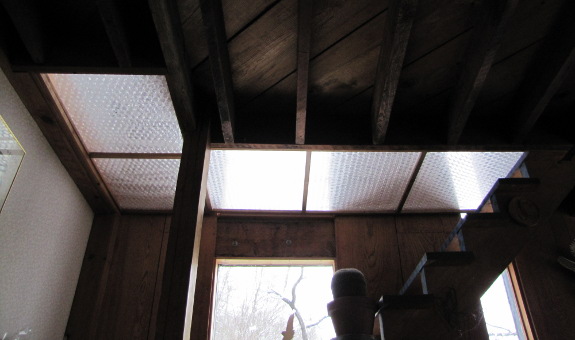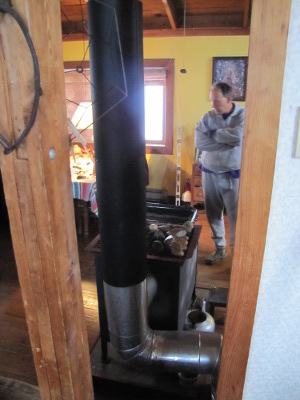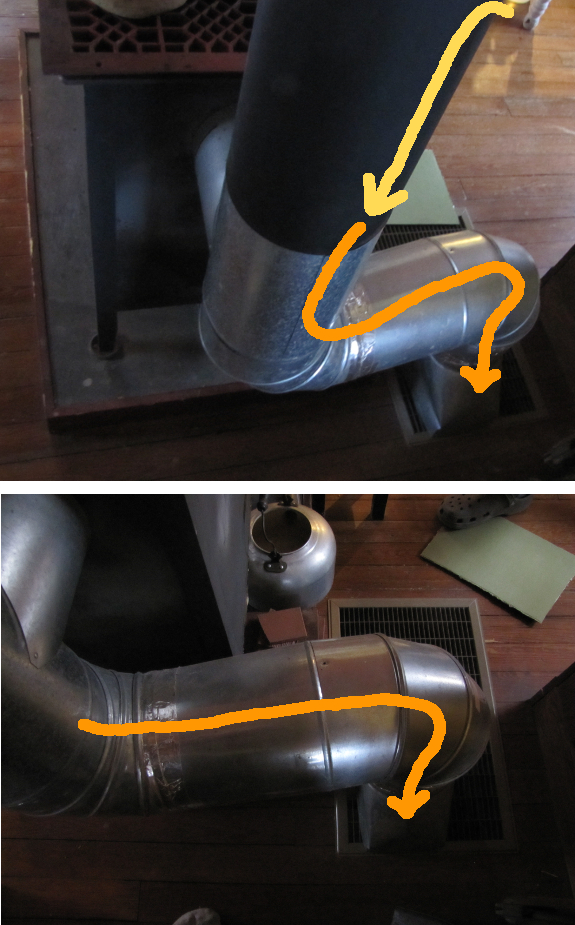
How to get wood stove heat to a lower floor

 Our
movie star
neighbor's home is three stories tall, and the wood stove is in the
main living space on the second floor. He made bubble-wrap
partitions (see the top photo) to close hot air out of the seldom-used
third floor while letting light shine down into the living room.
But his bathroom is downstairs, so he is stuck with the difficult
question --- how do you make hot air go down?
Our
movie star
neighbor's home is three stories tall, and the wood stove is in the
main living space on the second floor. He made bubble-wrap
partitions (see the top photo) to close hot air out of the seldom-used
third floor while letting light shine down into the living room.
But his bathroom is downstairs, so he is stuck with the difficult
question --- how do you make hot air go down?
A couple of years ago,
he installed a heat pump, but his experience matches my research ---
heat pumps are only marginally effective in cold weather in our
region. Still, the heat pump turned out to be the solution.
Our neighbor built a sleeve around the chimney pipe of his wood stove
and tapped it into the return air duct for the heat pump. Then,
when he wants to heat the downstairs, he simply turns on the fan for
the heat pump. The fan sucks hot air from above the stove,
through the sleeve where it is heated even more, then down to the lower
floors. Voila --- hot air running downhill!

Want more in-depth information? Browse through our books.
Or explore more posts by date or by subject.
About us: Anna Hess and Mark Hamilton spent over a decade living self-sufficiently in the mountains of Virginia before moving north to start over from scratch in the foothills of Ohio. They've experimented with permaculture, no-till gardening, trailersteading, home-based microbusinesses and much more, writing about their adventures in both blogs and books.
Want to be notified when new comments are posted on this page? Click on the RSS button after you add a comment to subscribe to the comment feed, or simply check the box beside "email replies to me" while writing your comment.

I like the bubblewrap partitions; cheap and effective. Ingeneous.
But in this case I wonder about the added value of a heat pump? IMO a fan should do the trick just as well. (of course a smaller pipe filled with water would do a much better job of transferring heat, but I digress)
With regard to your conclusions about heat pumps;
It is too generalistic, IMO. I'm assuming you are talking about a system where air or water is fed through a relatively shallow underground loop and a heat pump is used to extract heat from it. But with things like this the devil is in the details.
A heat pump is just a device that transforms energy from a lower to a higher temperature. A specific heat pump usually has a limited temperature difference that it can generate and a limited power. Besides a heat pump, a heating system as described above installation also needs an energy collector outside and a radiator inside.
And when sizing such a system you need to have at least an idea what kind of power you'll need for heating. A thorough understanding of thermo- and fluid dynamics and the specific performance of the components used is a requirement to get a successful result.
With around 8000 MW installed world-wide(1), there can be no question that geothermal energy works.
A shallow underground heat collector is indeed by definition not very efficient because of the relatively low temperature differences involved. That does not mean that the concept of using a loop plus heat pump for heating is not worthwhile. In this case the efficiency of the loop matters little because the supplied heat is free. It just means that you'll have to use a bigger collector to get a greater heat flow! The choice of heat transfer medium will also have a big influence. E.g. water is much better at absorbing and storing heat than air. (for a quick test; hold one hand in the air and stick the other hand in a bucket of room temperature water. Which feels colder?)
You're definitely right --- I should have been clearer and said that heat pumps as generally installed are only moderately efficient in our region. If you upgrade to producing a large-scale geothermal system, of course they would be more effective, but that costs orders of magnitude more money to install and requires a lot of flat ground, etc. When people talk about putting in a heat pump, that's generally not what they're talking about. They tend to call that a geothermal system.
Our neighbor doesn't turn on the heat pump when he's blowing hot air downstairs, just the fan. He has the heat pump for the milder part of the year, so it makes sense to use the system that's already in place to blow the hot air down even when it doesn't make sense to run the heat pump. If he didn't have the heat pump, using fans and ducts would make more sense.